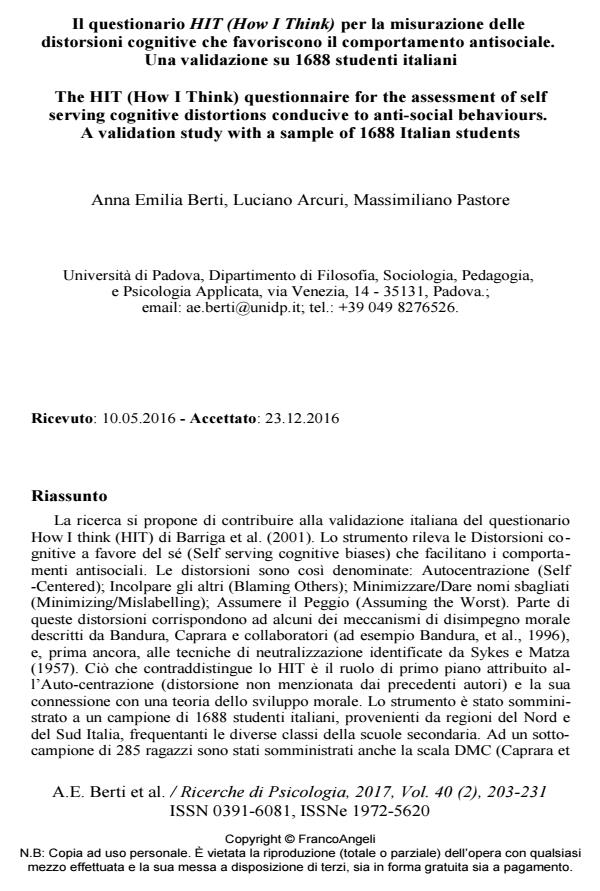The HIT (How I Think) questionnaire for the assessment of self serving cognitive distortions conducive to anti-social behaviours. A validation study with a sample of 1688 Italian students
Journal title RICERCHE DI PSICOLOGIA
Author/s Anna Emilia Berti, Luciano Arcuri, Massimiliano Pastore
Publishing Year 2017 Issue 2017/2
Language Italian Pages 29 P. 203-231 File size 350 KB
DOI 10.3280/RIP2017-002003
DOI is like a bar code for intellectual property: to have more infomation
click here
Below, you can see the article first page
If you want to buy this article in PDF format, you can do it, following the instructions to buy download credits

FrancoAngeli is member of Publishers International Linking Association, Inc (PILA), a not-for-profit association which run the CrossRef service enabling links to and from online scholarly content.
The present study aims to contribute to the Italian validation of the How I think questionnaire (HIT) (Barriga et al., 2001). The questionnaire is designed to assess four Self serving cognitive distortions contributing to antisocial behaviours: Self-Centered, Blaming Others, Minimizing /Mislabelling, Assuming the Worst. Some of these distortions have characteristics in common with some of the Mechanisms of moral disengagement described by Bandura, Caprara and coworkers (e.g.: Bandura et al., 1996) and with the Techniques of neutralization identified by Sykes and Matza (1957) even before. What characterizes HIT is its link to a theory of moral development and the central role assigned to Self-Centered (a distortion not mentioned by previous authors). Participants were 1688 secondary school students from Northern and Southern Italy (F = 45%), attending 9th-to-13th grades. A subsample of 285 students also completed the DMC questionnaire (Caprara et al., 2006) and Schwartz (1992) Value Survey. A subsample of 587 students from 9th, 11th and 13th grades also completed the scales of selfreported deviant behaviour and deviant behaviour disapproval from Jessor Health Behaviour Questionnaire (Jessor et al., 1992). Confirmatory factor analyses highlighted factors matching the four cognitive distortions. Convergent validity of the instrument was confirmed by significant positive correlations between cognitive distortions factorial scores and DMC (.68 < rs < .70) and selfreported deviant behaviours (.58 < rs < .59), and by the significant negative correlation with disapproval of deviant behaviours (-.58 < rs < -.68). A coherent pattern of correlations with values also emerged. We found positive correlations with power (.35 < rs < .40), hedonism (.28 < rs < .31), stimulation (.27 < rs < .31) and achievement (.15 < rs < .17) and negative correlations with benevolence (-.18 < rs < -.20), universalism (all rs = .20) and conformity (-.21 < rs < -.28) and spirituality (-.16 < rs < -.17). Lastly, an interesting curvilinear relation between age and scores of cognitive distortions is described and tentatively explained.
Keywords: Questionnaire validation, selfserving cognitive distorsions, antisocial behaviour; secondary school students, confirmatory factor analysis.
- Emotional and cognitive correlates of hating among adolescents: An exploratory study Ugo Pace, Alessia Passanisi, Giulio D'Urso, in Journal of Adolescence /2018 pp.159
DOI: 10.1016/j.adolescence.2018.08.002 - Hating Adolescents Test (HAT): a preliminary development of a measure to assess hating among adolescents Ugo Pace, Giulio D’Urso, Carla Zappulla, in Psychiatry, Psychology and Law /2020 pp.234
DOI: 10.1080/13218719.2020.1719374
Anna Emilia Berti, Luciano Arcuri, Massimiliano Pastore, Il questionario HIT (How I Think) per la misurazione delle distorsioni cognitive che favoriscono il comportamento antisociale. Una validazione su 1688 studenti italiani in "RICERCHE DI PSICOLOGIA " 2/2017, pp 203-231, DOI: 10.3280/RIP2017-002003